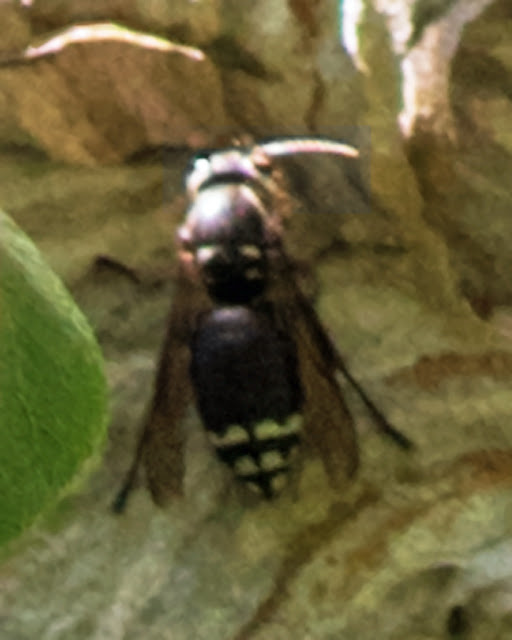Hornets had built a nest in the top of my friend's pear tree. I went over to see it.
 |
| A huge nest. |
These are bald-faced hornets, Dolichovespula maculata; large hornets that build a large nest that can reach up to about 50 to 60 cm, top to bottom. This one is well over 30 cm.; we'll measure it later at the end of the season, when the leaves have fallen.
 |
| An entry hole, with a few hornets. They came and went through several openings. |
 |
| See the face of a hornet peering out through his door. |
The nest contains a series of hexagonal combs, where the queen lays her eggs, and where the larvae develop, being fed by the workers. They wrap all this in layers of paper that the hornets make by chewing fibers from wood, combining it with saliva to make a paste that, dry, becomes paper. Here, they have collected material in several colours, laying down each colour separately.
 |
| Zooming 'way in; a fuzzy photo of one hornet. |
The face is mostly white, which gives the hornet its name: bald-faced. And at the end of the abdomen they have these three rows of wavy lines, white or slightly yellowish.
~~~~~~~~~~~~~~~~~~~~~~~~~~~~~~~~~~~~
Las avispas habían construido un nido en lo alto de un peral en el jardín de mi amiga. Yo fui a mirarlo.
Foto # 1: Un nido muy grande.
Estas son avispas sociales, el avispón cariblanco, Dolichovespula maculata. Son avispas grandes que construyen un nido grande, midiendo hasta 50 a 60 cm. de alto. Este nido bien pasa los 30 cm.; lo mediremos más tarde, una vez caídas las hojas del peral.
Fotos # 2 y 3: El nido, visto desde abajo, con algunas avispas. ¿Ves el que te mira desde su ventanita?
En el interior del nido han construido una serie de celdas de crianza hexagonales, donde la reina deposita sus huevos y los obreros cuidan y alimentan a las larvas. Todo esto lo protegen con una envoltura de papel que hacen masticando fibras de madera, haciendo con su saliva una masa que van colocando; al secarse se torna papel. Para este nido, han escogido madera de varios colores, gris, amarillo y café, y han depositado cada color por separado.
¿Será que las avispas pueden ser artistas?
Foto # 4: Haciendo zoom, un avispón algo borroso.
La cara es blanca, lo que le da el nombre de cariblanco. Y al final del abdomen tienen tres rayas ondeadas, o blancas o amarillas.

I know of an artist who left out some coloured copy paper for a little hornet artistry! I'll find a link
ReplyDeleteWhat a great idea!
DeleteThis is the best I could find.Not quite hornets, but still...
ReplyDelete